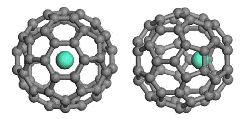Chemistry, Department of: Faculty Series

Xiao Cheng Zeng Publications
Document Type
Article
Date of this Version
2013
Citation
Published in Nanoscale (2013) 5: 9264. DOI: 10.1039/c3nr03167e
Abstract
Graphyne, a two-dimensional carbon allotrope like graphene but containing doubly and triply bonded carbon atoms, has been proven to possess amazing electronic properties as graphene. Although the electronic, optical, and mechanical properties of graphyne and graphyne nanoribbons (NRs) have been previously studied, their electron transport behaviors have not been understood. Here we report a comprehensive study of the intrinsic electronic and transport properties of four distinct polymorphs of graphyne (α, β, γ, and 6,6,12-graphynes) and their nanoribbons (GyNRs) using density functional theory coupled with the non-equilibrium Green's function (NEGF) method. Among the four graphyne sheets, 6,6,12-graphyne displays notable directional anisotropy in the transport properties. Among the GyNRs, those with armchair edges are nonmagnetic semiconductors whereas those with zigzag edges can be either antiferromagnetic or nonmagnetic semiconductors. Among the armchair GyNRs, the α-GyNRs and 6,6,12-GyNRs exhibit distinctive negative differential resistance (NDR) behavior. On the other hand, the zigzag α-GyNRs and zigzag 6,6,12-GyNRs exhibit symmetry-dependent transport properties, that is, asymmetric zigzag GyNRs behave as conductors with nearly linear current–voltage dependence, whereas symmetric GyNRs produce very weak currents due to the presence of a conductance gap around the Fermi level under finite bias voltages. Such symmetry-dependent behavior stems from different coupling between π* and π subbands. Unlike α- and 6,6,12-GyNRs, both zigzag β-GyNRs and zigzag γ-GyNRs exhibit NDR behavior regardless of the symmetry.


Comments
© 2013 The Royal Society of Chemistry. Used by Permission.